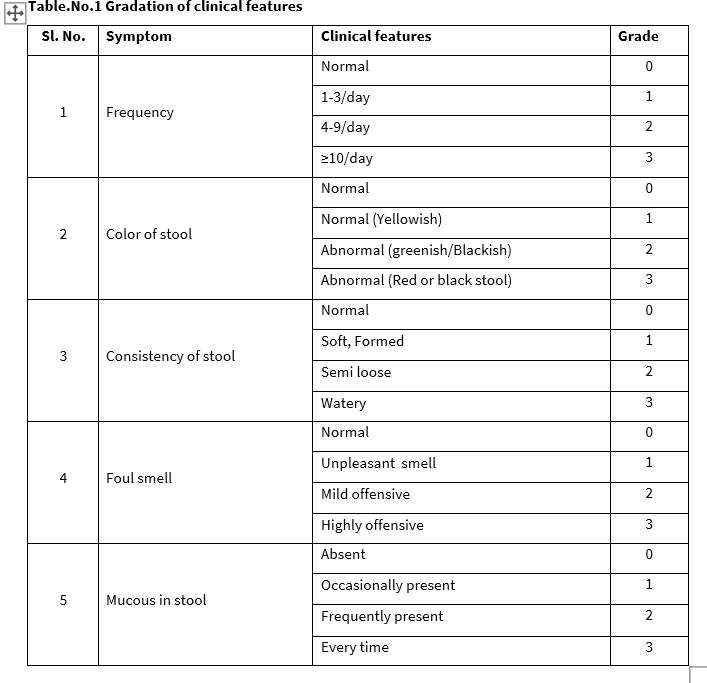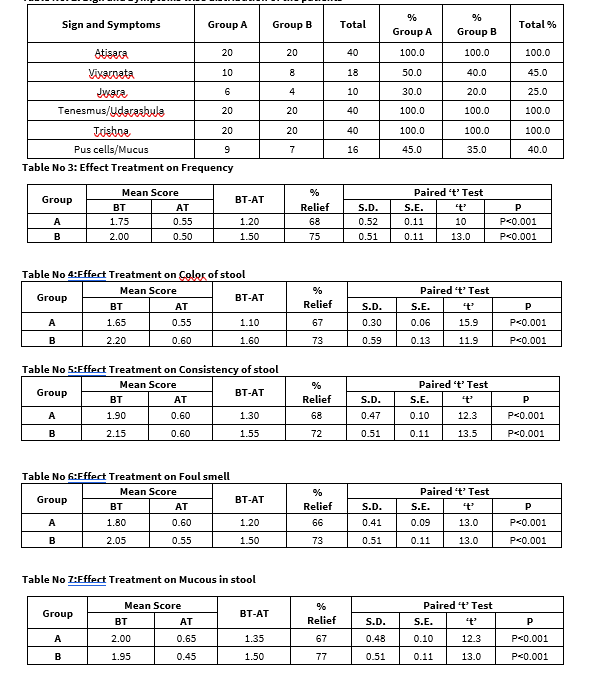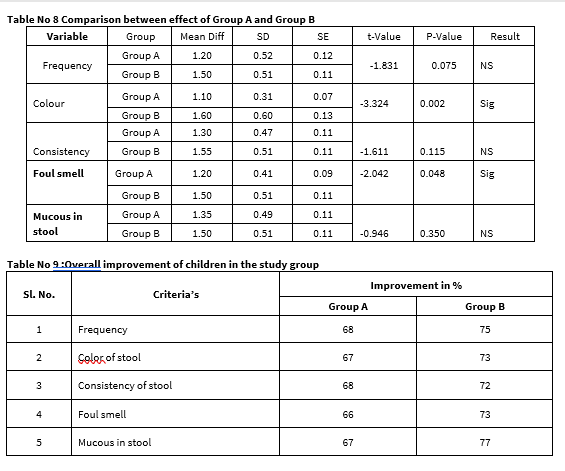Original Article
Year: 2021 |Volume: 2 | Issue: 10 |Pages: 7-17
A comparative clinical study to evaluate the effect of Pathadi Churna and Balchaturbhadra Yoga in the management of Atisara w.s.r. to ‘Bacterial Diarrhoea.
About Author
Correspondence Address:
Dr Harshad Dattatray Mane SDM Trust Ayurvedic Medical College, Post Graduation Centre and Padma Hospital, Terdal. Email: hmane44@gmail.com
Date of Acceptance: 2021-11-22
Date of Publication:2021-10-29
Article-ID:IJIM_104_11_21 http://ijim.co.in
Source of Support: Nil
Conflict of Interest: Nil
How To Cite This Article: Mane HD. A comparative clinical study to evaluate the effect of Pathadi Churna and Balchaturbhadra Yoga in the management of Atisara w.s.r. to ‘Bacterial Diarrhoea.’. Int J Ind Med 2021;2(10):7-17
Abstract
Balatisara meaning atisara in bala or childhood diarrhoea. It is observed that Patients of Bala Atisara mainly took shita jala pana, atiruksha, Atiguru, matra guru, samskar virudha ahara etc, also these Nidhan parivarjan is done & in some patients poorvarupa is observed like udarshul, daurbalya, trishna. Objective: To evaluate the efficacy Pathadi Churna and Balchaturbhadra and evaluate tits efficacy in the treatment of Balatisara. Methodology: It is Randomized Open label, clinical study conducted among 40 patients diagnosed as Balatisara (Diarrhoea) selected randomly from OPD or IPD of the hospital. The drug Pathadi Churna given for Group-A and Balchaturbhadra Yoga given to group B for 7 days. Results & Conclusion : In this it was found that both the drugs act against frequency of defecation and Balchaturbhadra Yoga drug is more effective than Pathadi Churna.
Keywords: Balatisara, Balchaturbhadra, Pathadi Churna, bala, Dosha
Introduction
Atisara in bala can be consider as Balatisara or childhood diarrhoea. It is the most common disease in children and is preventable as well as treatable disease. A significant proportion of Childhood diarrhoea can be prevented by safe drinking-water, adequate sanitation and proper hygiene. Childhood Diarrhoea is the second common cause of infant death and malnutrition worldwide.[1] In India ,nearly 1.5 million children’s die due to complications associated acute diarrhoea every year. [2] Infectious types of diarrhoea are considered as second most common cause of morbidity and mortality worldwide. [3] Diarrhoea still continues to be a major cause of hospitalization and death in children and has severe economic consequences. [4] The two most important consequences of childhood diarrhoea are malnutrition and dehydration.
Childhood Diarrhoea is the result of infection acquired through the fecal-oral route or by ingestion of contaminated food or water. Childhood Diarrhoea is associated with poverty, poor environmental hygiene and sanitation. Most common Enteropathogens that causes diarrhoea in children are Shigella, Enterohemorrhagic Escherichia coli, Campylobacter jejuni, Noroviruses, Rotavirus, Giardia lamblia, Cryptosporidium parvum, Entamoeba histolytica. These Enteropathogens can be transmitted by person-to-person contact, whereas others, such as cholera, are generally a consequence of contamination of food or water supply. Person-to-person direct contact outbreaks of gastroenteritis are usually caused by Norovirus and Shigella species. Some other pathogens including Salmonella typhi, Rotavirus, Giardia lamblia, Cryptosporidium, Clostridium difficile, and C. jejuni. [5,6]
This study was planned for assessment of clinical efficacy of Pathadi choorna[7] and Balchaturbhadra yoga mentioned by Bhavprakash and Bhaishajya Ratnavali in Balarogadhikara respectively. Pathadichoorna contains the ingredients Pathachatusrbhadra Yoga[8] mentioned in Bhavaprakasha and Baishajya Ratnav and Aamrabija. Balchaturbhadra Yoga contains Nagarmotha, Ativisha, Pippalikarkat Shringi. Both drugs are having Stambhana property and also having Agnideepan properties which would be beneficial in Samprapti break in Balatisara.
Objective:
To evaluate the efficacy Pathadi Churna and Balchaturbhadra and evaluate tits efficacy in the treatment of Balatisara.
MATERIALS AND METHODS:
Study Design: Randomized Open label, clinical study.
Sample Size: Total 40 patients diagnosed as Balatisara (Diarrhoea) were selected randomly from OPD or IPD of the hospital.
Group A: (Experimental) The drug Pathadi Churna, Dosage of the drug was fixed according to age adopting by Young’s Formula for 7 days.
Group B: (Control) Balchaturbhadra Yoga, Dosage of the drug was fixed according to age adopting by Young’s Formula for 7 days.
Young’s Formula: Child’s Dose = Age of child/ Age of child+12x Adults dose
METHOD OF COLLECTION OF DATA:
A special proforma Case Record Form (CRF) was prepared to take clinical history from patients as well as from parents. Subjective and objective parameters were included in case report form and it was documented before treatment and after treatment.
Inclusive Criteria:
- Age group of 5 - 14 years of either sex.
- Patients with complaining of passing loose stool 4-5 episodes per day with mild dehydration features were selected for present study.
Exclusive Criteria:
- Patients suffering from Balatisara with vomiting and moderate to severe dehydration, suffering from Pravahika and Visuchika, Dysentery, Diarrhoea associated with immune-deficiency disorder.
ASSESSMENT CRITERIA:
Subjective parameters:
Trushna, Agnimandya,Jwara, Avasada, Viplutata, Durgandha, Udarshool.
Objective parameters:
Stool Examination
- Frequency
- Color
- Consistency
- Foul smell
- Mucous
- Degree of dehydration. (W.H.O. guidelines)
- Stool examination – routine and microscopic

table

table

table

table
Results:
Age: It has observed that maximum numbers of children i.e. 35% each were belonged to the age group of 7-8 & 9-10 years age group, 12.5% were belonged to 13-14 years age group, 10% were belongs to 11-12 years and 7.5% were belongs to 5-6 years age group.
Gender: The study shows that maximum incidence of Diarrhea was reported in male 62.5% while the incidence in female was 37.5%.
Geographical Area: It has been observed that out of 40 children, 39(97.5%) were from rural and 1 (2.5%) were from urban area. This high incidence in rural area may due locality of hospital in rural area.
Socio-economic status: The incidence of Socio-economic status in the sample shows that, 31(77.5%) children belonged to middle class, 8(20%) belonged to lower class and 1(2.5%) was from upper class.
Hygienic environment: The incidence of hygienic environment of surrounding of children showed that maximum 38(95%) have lived in poor hygienic environment and 2(5%) have lived in good hygienic condition.
Ahara sevana prakara: Among 40 children, 22(55%) were on vegetarian diet and 18(45%) were non-vegetarian (Mixed) diet.
Koshta: Out of 40 children, only 5(12.5%) were having Mridu Koshta and 13(32.5%) were having Madhyama Koshta and remaining 5(12.5%) were belonging to Krura Koshta. Mridu and Madhyama Koshta may get easily vitiated with Pitta, Kapha and Vayu. Usually Pachaka Pitta and Samana Vayu get easily vitiated.
Agnibala: Maximum number of children 23(57.5%) were having Avara Agnibala while 12(30%) were having Madhyama Agnibala and remaining 5(12.5%) were having Pravara Agnibala. After treatment all patient observed with madhyama agnibala.
Nutritional status: The study shows that 95% children of the study group were having normal nutritional status only 5% children were in grade I malnutrition and no children were in Grade II, Grade III and Grade IV malnutrition.
Sign and Symptoms: It is observed that, out of the 40 patients taken for the study Atisara, Udarashula & Trishna was reported in 100%, 45% patients reported complaint of Vivarnata, 40% patients reported complaint of Pus cells/Mucus in stool, and 25% patients suffered from Jwara. In the clinical observations, symptoms like diarrohea, pain abdomen were observed in all of the children which were the main diagnostic features.
It is observed that, out of the 40 patients taken for the study Atisara, Udarashula & Trishna was reported in 100%, 45% patients reported complaint of Vivarnata,40% patients reported complaint of Pus cells/Mucus in stool, and25% patients suffered from Jwara.
Group A:On Frequency the effect of Pathadi Churnai.e. before the treatment the mean score was 1.75 and reduced to 0.55 after the treatment and this change that occurred with the treatment is statistically highly significant (P<0.001).
Group B: On Frequency the effect of Balchaturbhadra Yogai.e. before the treatment the mean score was 2.00 and reduced to 0.50 after the treatment and this change that occurred with the treatment, is statistically highly significant (P<0.001).
Group A:On Colorof stool the effect of Pathad iChurnai.e. before the treatment the mean score was 1.65 and reduced to 0.55 after the treatment and this change that occurred with the treatment is statistically highly significant (P<0.001).
Group B: On Colorof stool the effect of Balchaturbhadra Yogai.e. before the treatment the mean score was 2.20 and reduced to 0.60 after the treatment and this change that occurred with the treatment, is statistically highly significant (P<0.001).
Group A:On Consistency of stool the effect of PathadiChurnai.e. before the treatment the mean score was 1.90 and reduced to 0.60 after the treatment and this change that occurred with the treatment is statistically highly significant (P<0.001).
Group B: On Consistency of stool the effect of Balchaturbhadra Yogai.e. before the treatment the mean score was 2.15 and reduced to 0.60 after the treatment and this change that occurred with the treatment, is statistically highly significant (P<0.001).
Group A:On Foul smell the effect of PathadiChurnai.e. before the treatment the mean score was 1.80 and reduced to 0.60 after the treatment and this change that occurred with the treatment is statistically highly significant (P<0.001).
Group B: On Foul smell the effect of Balchaturbhadra Yogai.e. before the treatment the mean score was 2.05 and reduced to 0.55 after the treatment and this change that occurred with the treatment, is statistically highly significant (P<0.001).
Group A:On Mucous in stool the effect of PathadiChurnai.e. before the treatment the mean score was 2.00 and reduced to 0.65 after the treatment and this change that occurred with the treatment is statistically highly significant (P<0.001).
Group B: On Mucous in stool y the effect of Balchaturbhadra Yogai.e. before the treatment the mean score was 1.95 and reduced to 0.45 after the treatment and this change that occurred with the treatment, is statistically highly significant (P<0.001).
P-Value is greater than 0.05. Hence, we can conclude that, there is no significant difference observed between Group A and Group B in Frequency. While in Colour, p value is <0.05 we can conclude that, there is significant difference observed between Group A and Group B. In Consistency there is no significant difference observed between Group A and Group B. While in Foul smell, p value is <0.05 we can conclude that, there is significant difference observed between Group A and Group B. For Mucous in stool there is no significant difference observed between Group A and Group B.
In this study it is observed that overall improvement on the clinical features showed in the above table. From above table we may say that the improvement in all symptoms in group B is better than group A.
Discussion
Balatisara meaning atisara in bala or childhood diarrhoea. Diarrhea has its main impact on infants and young children in the poor section of the developing countries. Existence of malnutrition makes the child much vulnerable to suffer from diarrhea. It is observed that Patients of Bala Atisara mainly took shita jala pana, atiruksha, Atiguru, matra guru, samskar virudha ahara etc, also these Nidhan parivarjan is done & in some patients poorvarupa is observed like udarshul, daurbalya, trishna. According to bheda in Vataj- Atisar sashabda mala pravuruti todvat vedna. In Pittaj atisar pureesha with yellow, green, blue colour, with burning sensation & in kaphaj Atisar oily feces & white feces, cold, heaviness in the body all these lakshanas are found but after treatment all these lakshnas reduced & patient got marked relief. Atisara is the disease of GIT and it has aaharaj and viharaja Nidana and its samprapti involves vitiation of vata dosha and apa dhatu along with agnimandya and mala dravata. It ocuurs mainly due to unhygienic conditions that is why it is found more in children of low socio-economic status. As its samprapti involves agnimandya and mala dravata and the ayurvedic formulations used in its treatement usually have deepana, pachana and grahi property.
It was seen that the presence of greenish/Blackish color stool is found in almost all cases and after the treatment of both the groups maximum patients were found with Normal (Yellowish) stool, so both the drugs act against the color of the stool. After treatment the relief was 67% in group-A, and in group-B it was 73% this shows that Balchaturbhadra Yoga is more effective than Pathadi Churna. The study regarding consistency of stool after treatment the relief was 68% in group-A, and in group-B it was 72%. Before the treatment presence of foul smell is found in almost all cases of Group A and B patients, and after the treatment of both the groups maximum patients were free from foul smell. The 66% relief is found in group-A and 73% relief is found in group-B. It shows that the Group-B showed better result than Group-A. Before the treatment of A & B group patients, it was seen that the presence of mucous in stool is found in almost all cases and after treatment of both the groups maximum patients were free from mucous in stool, so it is clear that both the drugs act against the mucus. 67% relief was observed in Group-A and 77% relief is observed in Group-B. Both the drugs Pathadi Churna & Balchaturbhadra Yoga showed good results in all the signs and symptoms of the Balatisara but the group-B (Balchaturbhadra Yoga) showed higher efficacy than the Group-A (Pathadi Churna).
Discussion on mode of action of drugs:
Mode of action of Pathadi churna:
Pathadi churna works at various levels of samprapti of Atisar and correct Dosha Dushti and improves functioning of Agni. By virtue of its Tikta, Katu- Rasa, Katu-Vipak, Ushna-Virya, Laghu–Guna and Kapha shamak karma, Pathadi churna causes shoshna of Apa Dhatus which is Drava, Sara, Adra, Kledak, Sheeta and Guru and there by reduces the Atipravrti lakshana in Atisar. Pathadi churna reduces Agnimandya by its Tikta, Katu Rasa, Ushna veerya and Deepan guna, it acts as Ama pachan by Katu rasa, Katu vipak and Pachan karma. It causes Vata anuloman and thereby correct Vimarga gaman and Ati Drava pravriti lakshanas in Atisar. In this way Pathadi churna corrects Dosha dushti, improves Agni, functioning of Pakwashaya and treat the Atisar.
Mode of action of Balchaturbhadra Yoga:
Balchaturbhadra Yoga is an effective antiviral, antibacterial and anti-cold medicine. In addition to its therapeutic benefits, it also improves appetite, digestion, and hepatic functions.It also helps to treat common cold, fever, and upper respiratory tract infections. It improves appetite and digestion due to its appetizer and digestive stimulant actions. It increases gastric secretion and stimulates bile secretion from the liver, which helps to increase appetite and stimulates digestion. Balchaturbhadra Yoga has antispasmodic action. It gives relief from abdominal cramps by relaxing the abdominal muscles and thus, it provides relief in infantile colic. The antibacterial and anti diarrheal actions of this drug is benefit to reduce infection and frequency of loose stools in babies. Its ingredients, especially Ativisha reduce liquid content of the stools and help to restore the natural consistency of the stool. In addition, it also kills microbes responsible for diarrhoea.
Conclusion
In the present study, group-A is administered with Pathadi Churna and group-B with Balchaturbhadra Yoga, for 7 days. Regarding frequency of defecation after treatment the relief was 68% in group-A, and in group-B it was 75%. So, it was found that both the drugs act against frequency of defecation and Balchaturbhadra Yoga drug is more effective than Pathadi Churna. Because of result of clinical trial, we may conclude that both the drugs are effective in management of Balatisara (childhood diarrhea).
References
References:
- Bulletin of the World Health Organization, www.who.int/news-room/fact-sheets/detail/diarrheal-diease, may-2017.
- Wolfe I. Mitchell, Nolte B. Kurt, Yoon S. Steven, Fatal Infectious Disease Surveillance in a Medical Examiner Database, 2004 Jan; 10(1): 48–53.
- Bhan K. Maharaj et. al., Current concepts in management of acute diarrhea, Department of Pediatrics, All India Institute of Medical Sciences(AIIMS), Ansari Nagar, New Delhi
- Ameta P. et. al., Prevalence and Seasonal distribution of Rotavirus Diarrhea in hospitalized children less than 5 year old in South Rajasthan, International Journal of Biomedical Research 2015; 6 (03): 214-218.
- Paul Vinod K., Bagga Arvind, GHAI Essential Pediatrics, 8th edition, CBS publishers, 2013, New Delhi, P-291
- Kliegman, Stanton, ST. Geme, Schor, Behrman, Nelson Textbook of Pediatrics, 1st South Asia Edition, Vol.- II, chapter 341, Published by Elsevier, New Delhi, Reprint 2017, P- 1854
- Bhavaprakasha of Bhavamishra, English Translation by Prof. K.R.Shrikantha Murthy, Choukhamba Krishnadas Academy, Varanasi, Third Edition,2005, Page No 129.
- Baishajya Ratnavali, Hindi commentary By Prof. Venimadhav Ashwni Kumar Shastri, Chaukhambha Kruhsnadas Acadamy, Varanasi, Page no 670

